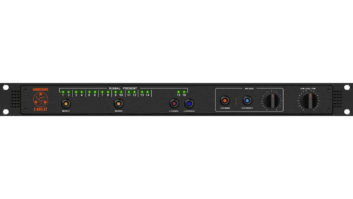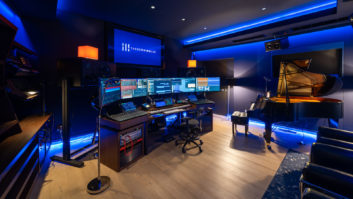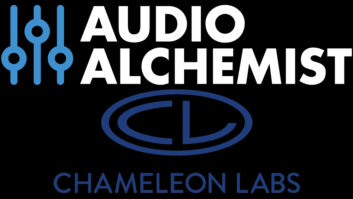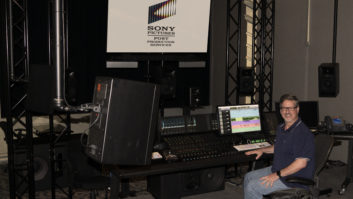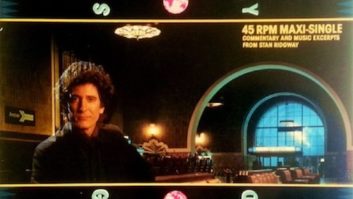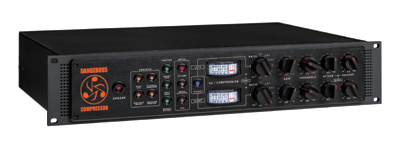
The 2-channel Dangerous Compressor presents a few new wrinkles on traditional VCA-based designs. These can be summed up in the unusual and flexible ways its sidechain detectors and, in stereo mode, attack and release controls work. The result is a hardware-based compressor that’s particularly transparent in mixing and mastering applications.
Innovative Design
The Dangerous Compressor’s front panel controls provide the first hint that the all-solid-state, Class-A/B processor has a trick or two up its sleeve, but there’s even more than meets the eye. Switch-selectable stereo and dual-mono operation are both offered, with a twist: Unlike most stereo compressors that sum the left and right channels and feed the combined signal to one detector circuit, the Dangerous Compressor uses both of its channels’ detectors in stereo mode. This prevents in-phase (mono) elements of your mix (such as bass guitar and the vocal’s dry component) from sparking heavier compression than out-of-phase, panned elements. The detector that’s triggered most heavily controls the gain reduction for both channels equally, preserving the stereo image.
In stereo mode, the makeup-gain and threshold knobs in the top row (controls used for the left channel in dual-mono mode) regulate both channels, but the two sets of attack and release controls work independently. (The two ratio controls should be set to the same position for stereo operation.) This construct allows you to, for example, dial in a slower attack time for a channel that has loud, panned tom hits in order to prevent them from sucking down the entire mix.
All switches for the two-rackspace compressor use pushbuttons. One switch toggles soft- and hard-knee responses, while another toggles manual and automatic attack and release times; a green status LED lights during manual operation. Automatic mode uses roughly 30 ms for both the attack and release times, whereas manual mode activates independent, rotary (continuously variable) attack and release controls for each channel. In manual mode, the attack time can be continuously varied from 1 to 100 ms, while the release time can be similarly adjusted between 10 and 500 ms. The channels’ ratio controls are stepped and provide seven choices between 1:1 and 20:1.
Switching on the compressor’s Smart Dyn function provides simultaneous RMS and peak detection. In this mode, peaks are acted on in a program-dependent manner with attack and release times that are faster than those used for processing average levels. Smart Dyn’s idiosyncratic dual-action response occurs whether you’re in automatic or manual mode, although in manual mode your attack and release settings do alter the Smart Dyn times (and vice versa). If this sounds confusing, don’t fret. Just toggle the Smart Dyn switch and see if you like what it does for your current program. The takeaway is Smart Dyn mode will yield slightly higher average levels for mixes and masters.
The Dangerous Compressor also provides a bevy of built-in sidechain features, each activated by its own switch. Bass Cut provides an HPF with 6dB/octave slope and a 3dB down point at 60 Hz. Sibilance Boost applies a Baxandall shelving filter above 1 kHz, resulting in a 2dB boost at 5 kHz. Another switch patches in an external sidechain signal (from an outboard equalizer, for example) via send and return jacks—provided separately for each channel—located on the rear panel. Once again, there’s a twist: Activating the external sidechain path does not defeat the internal sidechain’s bass-cut and sibilance-boost circuits—you can use them simultaneously to complement your external equalizer’s capabilities. Activating the Sidechain Monitor switch lets you hear the combined internal and external sidechain signals.
A VU meter and LED are provided for each channel, showing you when a light transient has exceeded the compressor’s threshold (the LED lights) and when average levels do so (shown by the VU meters in gain-reduction mode).
On the Back
Left- and right-channel I/Os and the sends and returns for external sidechain signals are on balanced XLR connectors on the unit’s rear panel. Recessed trims (one for each channel) allow you to zero the VU meters. An IEC receptacle—for use with the provided detachable, 3-pin power cord—rounds out the rear visage.
The frequency response is stated to be 15 Hz to 80 kHz, ±0.25 dB—ultra-wide and super-flat! Maximum level is over +27 dBu, affording you the confidence to strap the unit across the 2-bus inserts on a hot-running console. The noise floor is down over 93 dBu between 22 Hz and 22 kHz. THD+N is below 0.005%, and intermodulation distortion less than 0.007%, promising pristine sound.
In the Control Room
In stereo mode, the Dangerous Compressor sounded very clean and transparent on a full mix for a pop ballad. A 1.4:1 ratio, soft-knee and moderate attack and release times added nice glue to the mix with thresholds set high enough to make peak LEDs flicker and gain-reduction meters barely move. Activating the Smart Dyn function increased average levels slightly, enhancing fullness.
I also got outstanding results compressing a percussively strummed, stereo acoustic guitar in dual-mono mode. A soft knee, 4:1 ratio, and fast attack and release times gave a fantastic, in-your-face effect with 6 dB of gain reduction showing on the VU meters. (Considering the meters’ slow ballistics, there was undoubtedly a lot more compression than what was indicated.) Once again, activating the Smart Dyn function gave an even fuller effect. Equally impressive, considering the compression was so heavy: I heard no pumping, and the track’s depth sounded fully preserved.
A 4:1 ratio, soft-knee, 1ms attack and 500ms release time greatly improved a dry, beefy kick drum track that was claiming too much bass spectrum for the beater slap yet had virtually no shell sustain. With 7 dB of gain reduction showing on the VU meter, the beater hits sounded leaner and snappier, and the shell’s sustain was beautifully enhanced.
Even with hard-knee selected and Bass Cut and Sibilance Boost filters activated in its internal sidechain, the Dangerous Compressor could not de-ess female lead vocals. Patching an outboard equalizer—with highs cranked and lows cut—into the external sidechain’s patch points didn’t help. The unit’s attack time was simply too long, even at its fastest manual setting or in automatic mode, to attenuate the fleeting sibilance. In fact, the rela- tively slow attack time sometimes accentuated sibilance and breath noises.
In dual-mono mode, you can’t use different internal sidechain filters and knees and select a different manual/automatic mode for each channel. But to be fair, most 2-channel compressors work that way; you usually need to use two mono compressors to have that kind of flexibility.
The Dangerous Compressor shines the brightest in stereo applications, including mixing and mastering. (Just be aware most of the control knobs are not detented for exactly repeatable settings). If you’re looking for a very transparent-sounding 2-bus compressor and can afford the hefty price tag, the Dangerous Compressor is well worth an audition.
Mix contributing editor Michael Cooper is a recording, mix, mastering and post-production engineer and the owner of Michael Cooper Recording in Sisters, Ore.
Note: Dangerous Music has provided a link to a video showing the de-essing feature: http://youtu.be/ALou72mO6IA.
Try This
Snare drum sounds too clinical? Set the Dangerous Compressor to soft-knee mode, 3:1 ratio, 1ms attack and 500ms release time. Lower the threshold until the VU meters show 7 to 10 dB of gain reduction. The track will have more sizzle, ring and room tone.
Product Summary
COMPANY: Dangerous Music
PRODUCT: Dangerous Compressor
WEBSITE: dangerousmusic.com
PRICE: $2,799 (street price)
PROS: Very clean and transparent sound. Smart Dyn function increases average levels. Low ratios included for mixing and mastering. Internal sidechain filters.
CONS: Price out of reach for some. Worked poorly for de-essing.
